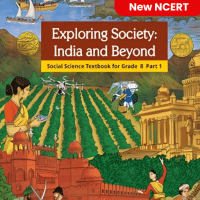Class 8 Exam > Class 8 Questions > Which material is used for making crucibles?a...
Start Learning for Free
Which material is used for making crucibles?
- a)Sulphur
- b)Silicon
- c)Graphite
- d)Phosphorus
Correct answer is option 'C'. Can you explain this answer?
Verified Answer
Which material is used for making crucibles?a)Sulphurb)Siliconc)Graphi...
Crucibles are used in the laboratory to perform high temperature reactions. They should resist high heating (they should not break). For this purpose, a mixture of graphite (an allotrope of carbon) and clay is used to make crucibles.
Most Upvoted Answer
Which material is used for making crucibles?a)Sulphurb)Siliconc)Graphi...
Crucibles are used in various industries and scientific laboratories to heat, melt, and analyze substances at high temperatures. They are typically made from materials that have high melting points, good thermal conductivity, and resistance to chemical reactions. Among the options provided, the correct material used for making crucibles is graphite.
Graphite as the Material for Making Crucibles:
1. High Melting Point: Graphite has an extremely high melting point of around 3,600 degrees Celsius (6,500 degrees Fahrenheit). This makes it suitable for applications where high temperatures are required, such as in metallurgy and chemistry.
2. Thermal Conductivity: Graphite is an excellent conductor of heat, allowing for efficient heat transfer within the crucible. This property is crucial when working with substances that require uniform heating or when precise temperature control is necessary.
3. Chemical Inertness: Graphite is chemically inert, meaning it does not readily react with most substances. This makes it ideal for use in crucibles, as it does not contaminate or react with the materials being heated or analyzed. It ensures the purity and accuracy of the experiments or processes taking place in the crucible.
4. Durability: Graphite is a strong and durable material, able to withstand repeated heating and cooling cycles without significant degradation. It is resistant to thermal shock, which is important when subjecting the crucible to rapid temperature changes.
5. Easy Machinability: Graphite can be easily shaped and machined into various crucible designs and sizes. This allows for customization and flexibility in meeting specific experimental or industrial requirements.
Other Materials:
a) Sulphur: Sulphur has a relatively low melting point and is not suitable for high-temperature applications like crucibles.
b) Silicon: Silicon has a high melting point, but it is not as thermally conductive as graphite. It is commonly used in the semiconductor industry but is less commonly used for crucibles.
c) Graphite: As mentioned earlier, graphite is the correct material for making crucibles due to its high melting point, thermal conductivity, chemical inertness, durability, and machinability.
d) Phosphorus: Phosphorus is a non-metallic element that is not commonly used for making crucibles. It has a relatively low melting point and is not as thermally conductive or chemically inert as graphite.
In conclusion, graphite is the preferred material for making crucibles due to its exceptional properties, making it suitable for high-temperature applications, efficient heat transfer, resistance to chemical reactions, durability, and ease of machining.
Graphite as the Material for Making Crucibles:
1. High Melting Point: Graphite has an extremely high melting point of around 3,600 degrees Celsius (6,500 degrees Fahrenheit). This makes it suitable for applications where high temperatures are required, such as in metallurgy and chemistry.
2. Thermal Conductivity: Graphite is an excellent conductor of heat, allowing for efficient heat transfer within the crucible. This property is crucial when working with substances that require uniform heating or when precise temperature control is necessary.
3. Chemical Inertness: Graphite is chemically inert, meaning it does not readily react with most substances. This makes it ideal for use in crucibles, as it does not contaminate or react with the materials being heated or analyzed. It ensures the purity and accuracy of the experiments or processes taking place in the crucible.
4. Durability: Graphite is a strong and durable material, able to withstand repeated heating and cooling cycles without significant degradation. It is resistant to thermal shock, which is important when subjecting the crucible to rapid temperature changes.
5. Easy Machinability: Graphite can be easily shaped and machined into various crucible designs and sizes. This allows for customization and flexibility in meeting specific experimental or industrial requirements.
Other Materials:
a) Sulphur: Sulphur has a relatively low melting point and is not suitable for high-temperature applications like crucibles.
b) Silicon: Silicon has a high melting point, but it is not as thermally conductive as graphite. It is commonly used in the semiconductor industry but is less commonly used for crucibles.
c) Graphite: As mentioned earlier, graphite is the correct material for making crucibles due to its high melting point, thermal conductivity, chemical inertness, durability, and machinability.
d) Phosphorus: Phosphorus is a non-metallic element that is not commonly used for making crucibles. It has a relatively low melting point and is not as thermally conductive or chemically inert as graphite.
In conclusion, graphite is the preferred material for making crucibles due to its exceptional properties, making it suitable for high-temperature applications, efficient heat transfer, resistance to chemical reactions, durability, and ease of machining.

|
Explore Courses for Class 8 exam
|

|
Question Description
Which material is used for making crucibles?a)Sulphurb)Siliconc)Graphited)PhosphorusCorrect answer is option 'C'. Can you explain this answer? for Class 8 2025 is part of Class 8 preparation. The Question and answers have been prepared according to the Class 8 exam syllabus. Information about Which material is used for making crucibles?a)Sulphurb)Siliconc)Graphited)PhosphorusCorrect answer is option 'C'. Can you explain this answer? covers all topics & solutions for Class 8 2025 Exam. Find important definitions, questions, meanings, examples, exercises and tests below for Which material is used for making crucibles?a)Sulphurb)Siliconc)Graphited)PhosphorusCorrect answer is option 'C'. Can you explain this answer?.
Which material is used for making crucibles?a)Sulphurb)Siliconc)Graphited)PhosphorusCorrect answer is option 'C'. Can you explain this answer? for Class 8 2025 is part of Class 8 preparation. The Question and answers have been prepared according to the Class 8 exam syllabus. Information about Which material is used for making crucibles?a)Sulphurb)Siliconc)Graphited)PhosphorusCorrect answer is option 'C'. Can you explain this answer? covers all topics & solutions for Class 8 2025 Exam. Find important definitions, questions, meanings, examples, exercises and tests below for Which material is used for making crucibles?a)Sulphurb)Siliconc)Graphited)PhosphorusCorrect answer is option 'C'. Can you explain this answer?.
Solutions for Which material is used for making crucibles?a)Sulphurb)Siliconc)Graphited)PhosphorusCorrect answer is option 'C'. Can you explain this answer? in English & in Hindi are available as part of our courses for Class 8.
Download more important topics, notes, lectures and mock test series for Class 8 Exam by signing up for free.
Here you can find the meaning of Which material is used for making crucibles?a)Sulphurb)Siliconc)Graphited)PhosphorusCorrect answer is option 'C'. Can you explain this answer? defined & explained in the simplest way possible. Besides giving the explanation of
Which material is used for making crucibles?a)Sulphurb)Siliconc)Graphited)PhosphorusCorrect answer is option 'C'. Can you explain this answer?, a detailed solution for Which material is used for making crucibles?a)Sulphurb)Siliconc)Graphited)PhosphorusCorrect answer is option 'C'. Can you explain this answer? has been provided alongside types of Which material is used for making crucibles?a)Sulphurb)Siliconc)Graphited)PhosphorusCorrect answer is option 'C'. Can you explain this answer? theory, EduRev gives you an
ample number of questions to practice Which material is used for making crucibles?a)Sulphurb)Siliconc)Graphited)PhosphorusCorrect answer is option 'C'. Can you explain this answer? tests, examples and also practice Class 8 tests.

|
Explore Courses for Class 8 exam
|

|
Signup for Free!
Signup to see your scores go up within 7 days! Learn & Practice with 1000+ FREE Notes, Videos & Tests.


















